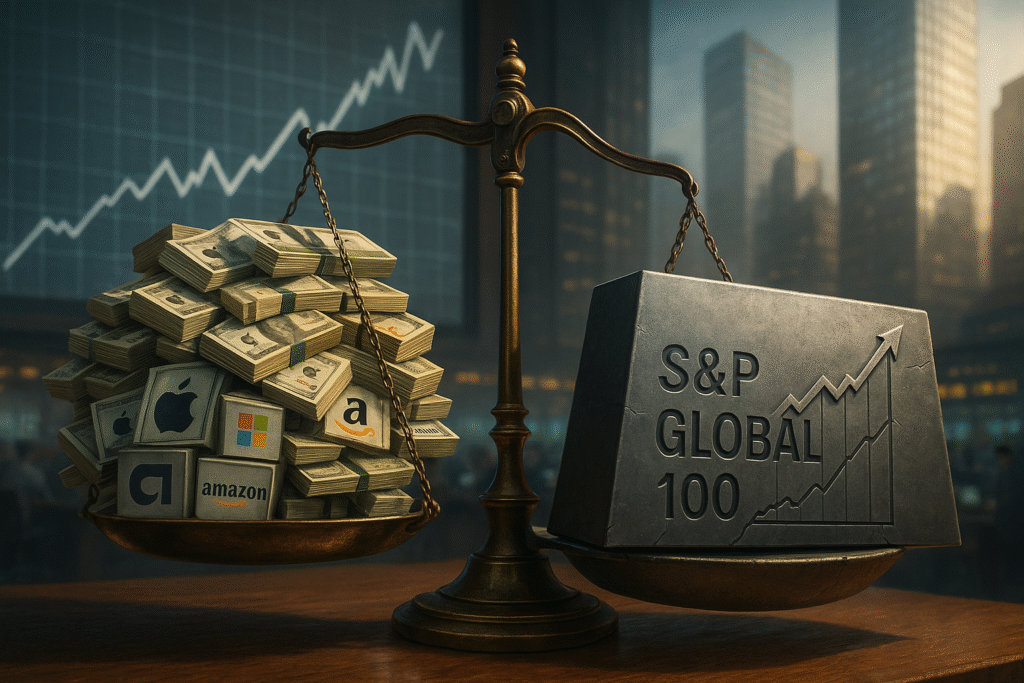An accelerated wave of share repurchases by the world’s largest companies has become impossible to ignore, marking a global buyback wave. This mega-cap buybacks trend—already north of $650 billion in new authorizations for 2025—has begun to distort the sector and single-stock balance inside the S&P Global 100. As free float shrinks, several companies are drifting toward the index’s 4 percent weight cap, prompting speculation that S&P and even MSCI may soon rethink their rules.

How Mega-Cap Buybacks Evolved in 2025
Corporate cash piles have swelled amid still-solid earnings and resilient margins. Instead of large acquisitions, boards have opted for direct returns to shareholders. Apple launched a record $110 billion authorization in April, Microsoft added $45 billion, while Saudi Aramco broadened its rolling buyback to roughly $40 billion per year. Luxury leader LVMH and Swiss drugmaker Novartis also boosted programs. Year-to-date, the dollar value of announced repurchases is running about 40 percent ahead of the comparable 2024 period.
Each transaction retires outstanding shares, pushing per-share earnings higher and inflating a firm’s float-adjusted market value. That, in turn, nudges its weight inside any capitalization-weighted index. The S&P Global 100 tries to keep that pull in check with a 4 percent per-name ceiling at quarterly rebalances, but the numbers tell the story: Apple’s weight has crept to 3.95 percent, Microsoft 3.78 percent, and Aramco 3.66 percent. Two more quarters of mega-cap buybacks at the current pace would breach the threshold.
Index Mechanics Feel the Strain
The S&P Global 100 selects one hundred of the largest, most liquid companies from the broader S&P Global 1200. Each quarter, index managers clip any weight above 4 percent and redistribute the difference across the other constituents. In theory, the rule guards diversification; in practice, it has forced larger and more frequent trades.
Consider Apple. If the company retires 2 percent of its float before the September review, its index weight would jump by roughly eight basis points, breaching the limit. On rebalance day, passive funds must sell that excess Apple stake and buy a proportional basket of the other ninety-nine names. Managers estimate that Apple alone has generated nearly $6 billion in forced turnover over the last twelve months.
Passive Fund Implications
ETFs such as iShares’ IOO and SPDR’s SGX track the S&P Global 100. They execute mechanical buying and selling in line with the index committee. Rising turnover increases tracking costs, widens bid-ask spreads around rebalance windows, and creates short-lived price pressure that fast traders exploit. The mega-cap buybacks trend is thus reshuffling not only weights but also trading patterns for some of the market’s largest passive products.
Sector and Regional Skews Intensify
Technology Dominance Expands with Mega-Cap Buybacks
Technology giants account for almost half the 2025 repurchase authorizations. When Apple, Microsoft, Alphabet, and Meta reduce share count, their weights climb between rebalances even after partial cap trims. Technology now sits near 27 percent of S&P Global 100 capitalization—up from 24 percent two years ago—tilting portfolios toward a sector already rich in valuation premium.
Energy and Luxury Join the Party
High oil prices have pumped free cash flow into integrated producers. Saudi Aramco’s steady open-market purchases and Exxon’s $20 billion program both boost the energy slice. In consumer discretionary, LVMH and Richemont have retired shares to ease earnings dilution from euro strength. Together, these actions spread the mega-cap buybacks momentum beyond Silicon Valley.
Could Index Rules Change?
Index providers have several levers:
- Lower the Cap: Moving to 3.5 percent or 3 percent restores balance but amplifies annual turnover.
- Introduce a Buffer: Allow weights to float 20–30 basis points above the limit intrareview, trimming only when the buffer is exceeded. This softens quarterly friction.
- Banding by Market-Cap Tier: Cap groups of companies rather than individuals, similar to FTSE’s approach, easing single-stock pressure yet maintaining diversification.
S&P Dow Jones Indices has not announced official consultations, but market participants expect the topic to surface in second-half policy discussions. MSCI, which uses a 5 percent cap in many global benchmarks, may face similar tension by 2026 if buybacks persist.
Navigating Portfolios in a Buyback-Heavy Market
Investors have several tools to adapt:
- Overweight Scarcity
Firms that reduce float fastest often see higher price-to-earnings multiples. Some active funds overweight these stocks until caps force rebalancing. - Trade Around Rebalance Days
Index-linked funds must trade at preset times. Liquidity spikes offer opportunities to buy capped names after passive selling or to short them ahead of known flows. - Diversify with Equal Weight
Switching a slice of exposure from cap-weighted indices to equal-weight versions can reduce single-stock concentration. - Scrutinize Valuations
Buybacks do not guarantee long-run outperformance if earnings growth fails. Investors should watch leverage and cash-flow stability as companies retire stock.
Risks to the Trend
Several developments could cool the mega-cap buybacks phenomenon:
- Higher Interest Rates: If yields rise, debt-funded repurchases look less attractive.
- Regulatory Curbs: Europe and the U.S. are debating stricter disclosure timelines and potential taxes on buybacks.
- Economic Slowdown: A profit downturn could shift corporate cash toward balance-sheet defense rather than shareholder returns.
None of these factors appear imminent, yet they warrant attention. Should buybacks slow, the pressure on index caps would ease, and passive-fund turnover might decline.
Outlook
For now, the mega-cap buybacks cycle shows little sign of fatigue. Strong free cash flow, limited capital-spending needs, and boardroom appetite for share reduction continue to propel the practice. The S&P Global 100’s current framework can handle sporadic spikes, but a persistent drift above the 4 percent line may force index committees to revisit long-standing rules. Investors would do well to stay alert: the mechanics of indices can move prices just as surely as earnings reports.